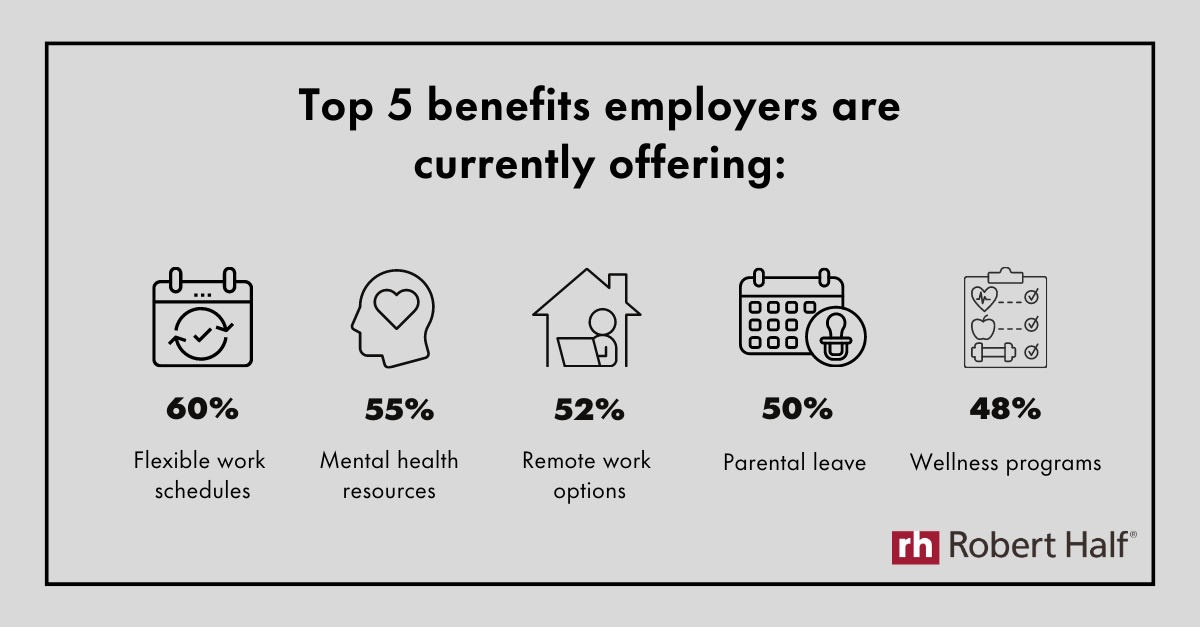In today’s highly competitive job market, employers are discovering that more than offering an attractive salary package is needed to attract and retain top talent.
Instead, an increasing number of candidates are placing a higher value on the benefits and perks that come with a job offer. In fact, according to the 2023 Salary Guide by specialised recruiter Robert Half, almost two-thirds of Australian employers have had a candidate accept a job offer because of their company’s benefits package, even when their salary expectations were not met.
According to the study, Australian employers increasingly recognise the value of offering attractive benefits packages to attract and retain top talent.
The survey found that 63 per cent of employers have successfully convinced candidates to accept job offers by offering appealing benefits, even when they could not meet the candidate’s salary expectations.
This trend emphasises the importance of benefits to employees in today’s highly competitive job market. Employers have identified the need to offer various benefits catering to their employees’ varied needs and preferences. Among the most commonly offered benefits are flexible work schedules, with 60 per cent of employers providing this option, followed by mental health programs (55 per cent), remote work options (52 per cent), extra paid parental leave (50 per cent), and wellness programs (48 per cent).
To remain competitive and retain top talent, the Salary Guide reveals that 70 per cent of employers plan to increase their benefits in 2023. Additionally, 67 per cent of employers plan to offer employees the option to swap a proportion of their salary in return for non-financial perks, such as holidays or other benefits.
As the competition for skilled workers intensifies, offering an attractive benefits package can make all the difference in attracting and retaining the best employees. Employers must continue to evaluate their benefits offerings and tailor them to meet the changing needs of their workforce to remain competitive in the current job market.
“With many companies focused on cost management, businesses might not be in a position to award pay rises or higher starting salaries amid economic uncertainty, said Nicole Gorton, Director at Robert Half.
“While salary is a prime motivator and the main incentive of a remuneration package, offering a competitive salary is just one piece of the puzzle. Businesses increasingly recognise the benefits’ power to land, motivate, engage and keep their top performers.”
“Australian companies benefit from diversifying their incentives offerings beyond the purely financial aspect as professionals seek the complete package and place added emphasis on quality of life,” said Nicole Gorton, Director at Robert Half.
What companies are currently offering
Many Australian businesses have embraced the shift towards prioritising employee benefits. In fact, many employers have already implemented a range of benefits catering to their workforce’s diverse needs.
One of the most commonly offered benefits is flexible work arrangements. This may include flexible hours, compressed work weeks, and the option to work remotely or from home. These arrangements give employees greater control over their work-life balance and can help improve job satisfaction and overall productivity.
In addition to flexible work arrangements, many employers offer benefits specifically designed to support their employees’ lifestyles and health. These benefits may include mental health programs, wellness initiatives, and extra paid parental leave. Such programs and initiatives demonstrate a company’s commitment to employee well-being and can improve employee engagement and retention rates.
As the competition for top talent intensifies, employers are exploring new ways to enhance their employee value proposition and stand out as an employer of choice. In particular, they seek to go beyond the traditional salary and bonus packages and offer a diverse range of perks and benefits that meet today’s workforce’s changing needs and priorities.
Flexible work arrangements are among the most popular benefits currently offered, with many employers planning to introduce new initiatives in 2023. For example, an early finish on Friday afternoons is the most popular initiative, with 30 per cent of employers planning to implement this perk.
A compressed work week, in which employees work the normal number of hours in fewer than five days, is the second-most-popular option planned by 29 per cent of employers.
In addition to flexible work arrangements, employers are also planning to bolster their employees’ leave entitlements. Some are planning to extend the provision of commonplace leave entitlements, such as extra paid annual leave, paid parental leave, and a leave of absence or sabbatical, while others intend on offering paid domestic violence leave and paid menopause leave.
To support their employees further, allowances and assistance programs are also planned to be offered more commonly. Australian employers intend to provide a range of benefits, including a remote work business allowance, a car allowance, and subsidised meals at work. Modern perks such as wellness programs, the ability to make extra superannuation contributions, and childcare assistance are also on the cards for more Australian employees.
Employers are also looking at how they can broadly support their employees’ lifestyles in 2023.
For instance, some are planning to offer reproductive health benefits to support IVF treatment, health insurance, and financial planning assistance. By expanding their benefits packages in this way, employers are positioning themselves as employers of choice, which can help to attract and retain top talent in the long run.
“To empower their employees and elevate their organisation as an employer of choice, business leaders are upping the ante when it comes to their benefits program. Australians are actively seeking job opportunities that satisfy their monetary ambitions and their lifestyle needs, such as financial and mental health support being offered on top of the highly sought-after flexibility benefits.”
“A company’s perks and benefits structure is reflective of their wider corporate culture, so innovative and comprehensive packages not only help attract and retain top talent, but they can also support a long-term talent pipeline of employees and help build staff engagement overall,” concluded Gorton.
Keep up to date with our stories on LinkedIn, Twitter, Facebook and Instagram.

